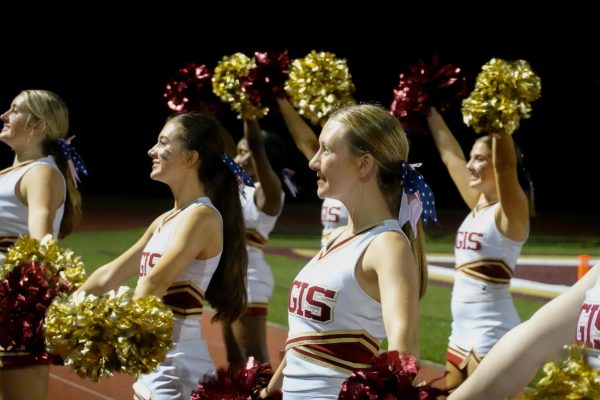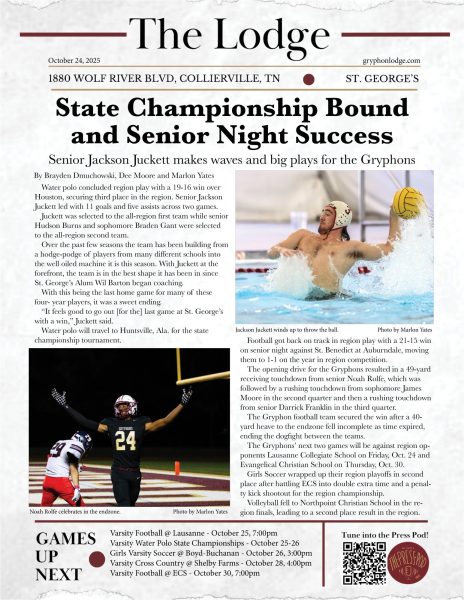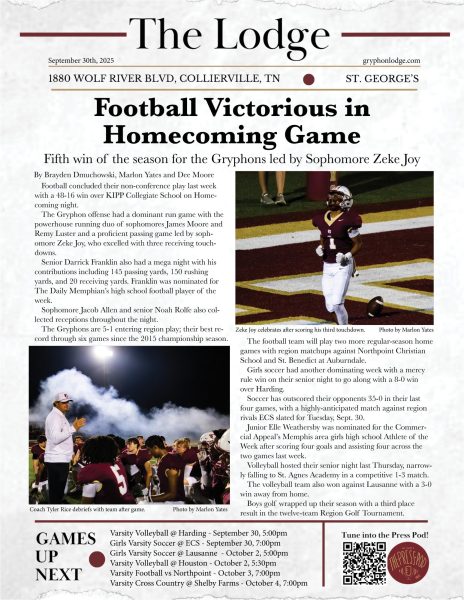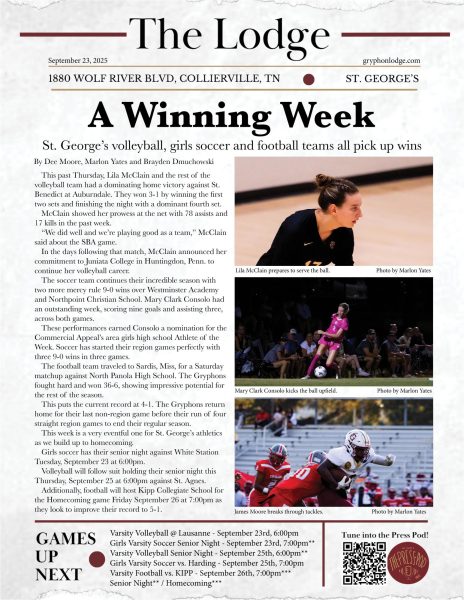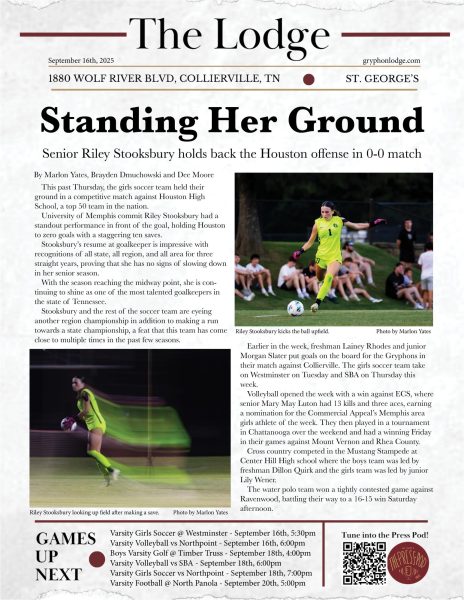Finish strong
When Marshall Shanks came to St. George’s, he just wanted to be remembered for something.
When he graduates this spring, his story is unlikely to be forgotten any time soon.
Marshall Shanks has always been fast. In lacrosse, the team once ran sprints with the Coach telling players they would stop when someone beat Marshall, after awhile, players urged Shanks to stop trying.
Everyone involved with sports at St. George’s knew Shanks was fast. Among these people, was former track coach Andre Miller who asked Shanks to run in a post-track season meet late in Shanks’ eighth grade year.
At the time, Shanks was focused on playing basketball and lacrosse, but he decided to run anyway, a change that would completely change the course of his educational experience.
Coach Miller was the first to realize he had definite potential. He encouraged Shanks to run track his freshman year.
“Ninth-grade year, the D2 City championship was when I won my first race,” Shanks said. “That’s when I realized I’m actually good at this.”
Since then, Shanks has run the 100-meter dash in 11.29 seconds, and the 200-meter in 23.74 seconds. In indoor competition, Shanks ran the 60-meter in 7.46 seconds and took 7.13 seconds in the 55-meter dash.
When Shanks began to think about college early in his high school career, he came to the realization that academically he was not a strong candidate for admission at schools he was interested in. It was then that Shanks realized he could use his gift to help get him into college.
“So, I started looking at my options, like football. Can I really do football? You really look at me and you look at football, nah. Basketball, am I really that good? Nah.” Shanks said. “But track, that’s you. That’s you, buddy.”
So, Shanks started running competitive track the summer after his freshman year with teammate and mentor Chazz Simmons, who graduated from St. George’s in 2015.
“He told me, ‘You ain’t the best, so you gotta show everybody why you wanna be the best,’” Shanks said. The two began running more together and pushed each other to be their very best.
“I helped him by giving him advice … He is the runner he is today because of the qualities of his work ethic,” Simmons said. “When we trained together, he inspired me to continue to work hard. On days that I wasn’t feeling like running, he would uplift me and his mood was contagious.”
In addition to Simmons, Coach Lott and Shanks’ AAU coaches helped Shanks stick with track by encouraging him and motivating him.
“Chazz, he pushed me,” Shanks said. “Coach Lott, he pushed both of us. If it wasn’t for those four people, I promise you I would’ve quit a long time ago, and I would not be doing track in college.”
Fortunately, Shanks stuck with the sport and became more and more involved, dedicating four-and-a-half hours a week to competitive track alone.
A typical week of competitive track is three days. On Tuesdays, the team does yoga or pilates, while on Thursdays, the team might run “pyramids” (600m, 450m, 300m, 150m) and work on starts.
Saturdays are usually either a meet day or a combination of a Tuesday and Thursday workout with additional weight-lifting. Every practice ends with a mile cool down run.
“Running takes up all your time,” Shanks said. Shanks runs indoor and outdoor track from October to mid-February, and mid-February to May he focuses on outdoor track. He then runs AAU track from May to August, and he finishes with running cross country in the fall.
“It really helps that he does cross country [and] indoor track and field and brings it over to outdoor,” Coach Lott said, adding, “You have to focus on your strength, your weight, and he does that.”
Challenges on the track have proven to be difficult but manageable for Shanks, who found that his problems coming to the Collierville Campus were tougher to work with.
“It wasn’t hard for me to transition over here. It was just hard to get people to notice who I was. Shanks said. “All I wanted was just acceptance.”
Instead of becoming frustrated, Shanks pushed himself to be better, taking his frustrations out by working his hardest every time he stepped on the track.
“I just wanted to be remembered by something,” he said. “I tried so hard to fit in with the Germantown people not realizing I was veering off from being my own person. I spent four years trying to find myself… but then I realized who I wanted to be.”
Just when it seemed Shanks’ troubles were in the past, he was dealt his toughest blow yet.
“The loss of my father last year, that was a big setback, but at the same time, that was a big motivation for me. It actually pushed me to my limit,” Shanks said.
If Shanks had wanted to throw in the towel after this, no one would have questioned him, but instead of using it as an excuse to quit, he used it as inspiration.
In the weeks following the passing of his father, Shanks recorded three personal best times to that point in his career.
“I gotta push myself more because he expected high expectations from me,” Shanks said.
Shanks has been blessed in his track career with great teammates. As an underclassman, Shanks worked with mentor Simmons, who pushed him. After Simmons graduated, Shanks began to work with junior Bryan Payne.
“If he saw something that I needed improvement in one of my races, he would help me out in practice and tell me what I need to do to fix what I need to fix,” Payne said. Payne was also helping Shanks out, too.
“He personally pushed me last year to be better. Me and him were at the same speed, so it’s like I gotta be better,” Shanks said.
Coach Lott has even noticed the healthy rivalry between the two.
“They always push each other in practice. You have to be competitive. Track is not easy. It’s a real man-slash-woman sport. You can’t just go out there and talk the talk – you have to walk the walk” Coach Lott said
Shanks started to get serious looks over the summer. He considered Birmingham-Southern College, Tiff University, Berea College, University of St. Mary’s, and Methodist University among others. Shanks ended up committing to run track at Fisk University.
“I wanted to go to a HBCU,” Shanks said. “I just need to be around my people. I’ve been at St. George’s all my life and I’ve been around every single race and culture and I really wanna just experience my culture.”
Balancing athletics and academics in a college setting can be tough, but Coach Lott, who played college football, thinks St. George’s has prepared Shanks well.
“Not only do we focus on athletics, we focus on academics first, and being able to focus on time management is huge,” Lott said. “I think he’ll do very well in that.”
Shanks is now starting to get looks from division-one schools, but he is not interested. He is committed to Fisk and is excited about his opportunity.
Now in his senior year, Shanks will serve not only as a star runner but also as a team leader. Shanks is dedicated to his track team and knows that, in the past, he could have been a better leader.
“I have to learn self-discipline and when to act like a captain and when to fall back and be a regular teammate,” Shanks said. “Last year, I took advantage of everybody a little too much. I thought I knew everything.”
Shanks, always his own toughest critic, may still have work to do, but Payne is complimentary of the job he has done so far.
“Last year, I really noticed that he’d become a leader,” Payne said. “I know that track is an individual sport, but when he’s running, he’s trying to help other people around him so they can do better running track, too.”
Coach Lott is hoping to see Shanks lead the team to a state championship this year.
“I’m expecting him to run some faster times this year, really push himself to the state championship, so we’ll see how it goes,” Lott said. “He knows I have high expectations for him.’
Shanks has grown over the years as a person and a runner because of his hard work and mentors, but he is just getting started.
“He’s come a long a way but still has a lot of work to do,” Lott said.







